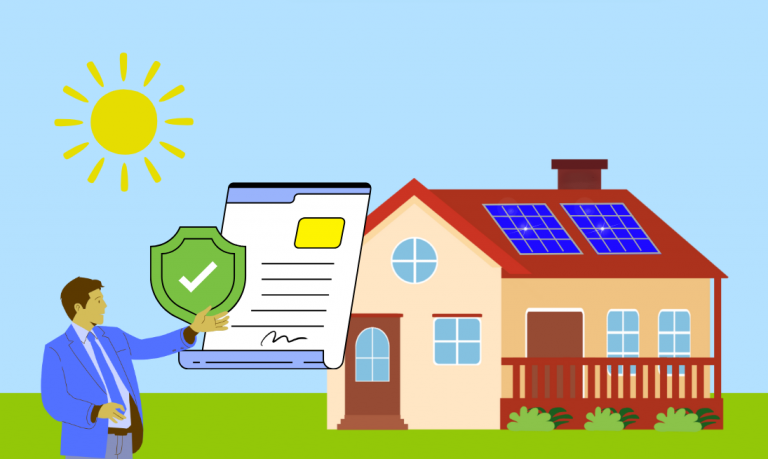
Solar Energy
Getting Started with Solar
The City of Pico Rivera aims to boost solar energy and development in the community. The City provides resources on solar basics, options, permitting, inspections, and state compliance. Check the California Public Utilities Commission’s Solar Consumer Protection Guide and the Department of Energy’s Homeowner’s Guide to Going Solar for more information.
Pico Rivera is also working to become a SolSmart community, adopting best practices to make solar installation easier for residents and businesses. SolSmart, funded by the U.S. Department of Energy, helps local governments promote solar energy. Learn more about the program here.


Our Solar Commitment
The City of Pico Rivera Office of Sustainability is committed to providing excellent customer service regarding solar processes. To support the ongoing advancement of solar energy in the community, the City is committed to the following:
- Providing guidelines for the solar permitting and inspection process through SolarAPP+.
- Providing clear and transparent information to residents with a comprehensive residential solar permitting checklist.
- Processing small rooftop solar PV permit applications through a portal that provides automated plan reviews, permits, payment processing, and inspection scheduling via SolarAPP+, with most applications typically processed the same day.
- Offering solar project inspection within a 2-hour window.
- Providing excellent customer support through the Building and Safety Division at 562.801.4360 or permitsupport@pico-rivera.org.
- Ensuring equitable access to solar by offering a catalog of programs under PRIME Power Choice.
Pico Rivera Innovative Municipal Energy (PRIME) has recently partnered with Tesla Inc. and Participate. Energy to launch Power Choice. This exciting new program provides residents with the opportunity to harness the benefits of solar power and battery storage— without the burden and costs of installation and ownership. Read More →
The Benefits of Going Solar
Solar energy harnesses the sun as a renewable resource, benefiting individuals and the community by reducing carbon emissions and air pollution, supporting local solar businesses and the Solar Energy Industries Association, creating jobs, lowering energy costs, and enhancing electric grid resilience during peak demand.
Please watch this video by Simply Solar for more information on how solar energy benefits the environment.

Solar Maps and Potential
Visit Google Project Sunroof for a personalized solar savings estimator. Solar savings are calculated using roof size and shape, shaded roof areas, local weather, local electricity prices, solar costs, and estimated incentives over time.
Estimates the potential performance of PV installations using the PVWatts Calculator.
Consumer Protections, Solar Right, and Procedures
California State policies require solar providers submitting interconnection applications for residential solar customers in Southern California Edison’s (SCE) service area to collect initials and a signature on the California Solar Consumer Protection Guide. This guide informs customers on (1) solar suitability, (2) roles and processes, (3) finding a qualified provider, (4) comparing financing options, (5) electricity bill savings, (6) reading paperwork, (7) reviewing resources, and (8) completing the checklist before the signature page.
- Solar United Neighbors’ Solar Owner’s Manual – serves as a support for solar homeowners whether you’ve just gone solar or you’ve had solar for years.
- A Beautiful Day in the Neighborhood: Encouraging Solar Development through Community Association Policies and Processes – includes details on how communities can encourage solar development through community association policies and processes.
- The California Public Utilities Commission (CPUC) presents the California Solar Consumer Protection Guide. The CPUC recommends that solar providers give out this guide during their first contact with potential customers.


HOAs and Solar Photovoltaic
Civil Code Section 714 is part of the “California Solar Rights Act” and limits how much associations can restrict the installation of solar energy systems by members:
- Any restriction in deeds or governing documents that prohibits or restricts the installation or use of a solar energy system is void
Finding a Contractor and Going Solar
Find a solar contractor(s) to assess your home or business for solar energy and provide a quote.
- Certified practitioners can be found through NABCEP.
- Visit EnergySage to learn about solar energy and submit for solar quotes from a network of pre-screened, local solar installers.
- Solar Customer Resource Portal – various resources from SEIA, the Solar Energy Industries Association.
- Solar Owner’s Manual – information for current solar homeowners to ensure they are getting the most out of their system from Solar United Neighbors.


Financing, Incentives, and Tax Exemptions
The Clean Energy States Alliance Homeowner’s Guide to Solar Financing overviews different financing options.
Federal Incentives
- Rebates and incentives are available through the Inflation Reduction Act. Calculate your eligibility using the Rewiring America Calculator.
- The Federal Investment Tax Credit helps reduce residential solar PV system costs. Visit the U.S. Department of Energy for a Homeowner’s Guide to the Federal Tax Credit for Solar Photovoltaics.
- Businesses can refer to the Federal Solar Tax Credits for Businesses.
State and Local Incentives
The North Carolina Clean Energy Technology Center provides an overview of state incentives.
Get Involved, Stay Informed


Typically, solar installations are paid for through loans, upfront payments, or a power purchase agreement (PPA).
- A Homeowner’s Guide to Solar Financing is a resource from the Clean Energy States Alliance that provides an overview of the different financing options.
Federal Incentives: There are many new incentives and funding opportunities available for solar and other clean energy technologies.
- A great place for residents to start identifying the federal incentives for which they are eligible is this calculator from Rewiring America. The rebates and incentives available through the federal Inflation Reduction Act can vary depending on your location and income.
- Additional details about benefits in the Inflation Reduction Act can be found on the White House’s website or the Department of Energy website.
- The Federal Investment Tax Credit for residential solar continues to be one of the most significant ways to reduce the cost of your solar PV system. Learn more about the federal tax credit, eligibility, and other common questions & answers in the Homeowner’s Guide to the Federal Tax Credit for Solar Photovoltaics from the U.S. Department of Energy.
- Businesses should refer to the Federal Solar Tax Credits for Businesses.
- Some solar projects will be eligible for bonus credits on top of the 30% Investment Tax Credit. The Inflation Reduction Act provides up to 20% in bonus credits for qualified solar or wind facilities developed in low-income communities; up to 10% bonus for projects located in “energy communities” that have a historic fossil-fuel economy, high unemployment or are developing solar on a brownfield; and 10% domestic content bonus for projects using the required amounts of U.S.-produced steel, iron and manufactured products.
- The World Resources Institute has created an IRA Bonus Mapper tool to help identify communities that are eligible for the low income and energy community bonus credits.
- Tax-exempt organizations, including non-profit organizations, schools, and government entities, can now take advantage of the federal tax credit through “elective pay” (sometimes referred to as “direct pay.”) An overview of elective pay and Frequently Asked Questions are available from the IRS.
State and local incentives:
- Information about state incentives can be found in this database maintained by the North Carolina Clean Energy Technology Center.
- Many new state programs are expected to be announced in 2024 as a result of federal funding. Stay tuned for announcements from your state!

Job Training and Educational Opportunities
If you are interested in pursuing a career in solar energy, here are some links to regional and national educational courses, programs, and/or trainings offered from colleges, universities, technical institutions, and non-profits.
More Useful Information
Energy and Power links:

Solar Energy in The City of Pico Rivera
Getting Started with Solar
The City of Pico Rivera has a goal to increase solar energy and encourage solar system development in the community. The City offers a collection of solar information and resources about the basics of solar energy, your solar options, the online permitting process, inspections, questions to ask solar professionals, and information about adhering to state solar goals. Read the California Public Utilities Commission (CPUC) Solar Consumer Protection Guide and visit the Department of Energy’s Homeowner’s Guide to Going Solar.
The City of Pico Rivera is working to become a SolSmart designated community by implementing best practices to make it easier for residents and businesses to install and access solar energy. SolSmart is a national program funded by the U.S. Department of Energy that has helped hundreds of local governments become “open for solar business.” Learn more about the program here.
Our Solar Commitment
The City of Pico Rivera and Office of Sustainability is committed to exceptional customer services as it relates to solar processes. To promote the continued advancement of solar in the community, the City is committed to the following:
- Provide clear guidelines about the solar permitting and inspection process https://www.pico-rivera.org/residential-solar-permit-online-pilot-program/ with SolarAPP+.
- Process small rooftop solar PV permit applications through a portal that provides automated project plan reviews, automated permits, online payment processing, and online scheduling for inspections. https://solarapp.nrel.gov/login
- Offering inspection appointment times for solar projects within a 2 hour window.
- Provide excellent customer support through the Building and Safety Division at 562.801.4360 or permitsupport@pico-rivera.org.
- The City of Pico Rivera ensures equitable access to solar by offering a catalog of programs under the Pico Rivera Innovative Municipal Energy Division (PRIME)
- The City of Pico Rivera ensures equitable access to solar by offering a catalog of programs under the Pico Rivera Innovative Municipal Energy Division (PRIME). The Power Choice program offers PRIME customers the opportunity to benefit from solar and battery storage without the cost of installing and owning a system. PRIME has partnered with Tesla, Inc. to install rooftop solar and Tesla Powerwall batteries at no upfront cost.
The Benefits of Going Solar
Solar energy uses a renewable energy source – the sun – and provides many benefits for individuals and the community. It improves environmental quality by reducing carbon emissions and air pollution, supports local solar companies in California, https://www.seia.org/state-solar-policy/california-solar, creates local jobs, saves money on energy costs, and improves electric grid resilience during peak demand and other stresses to the system.
Please watch this video by Simply Solar for more information on how solar energy benefits the environment.
Solar Maps and Potential
Investigate your property’s solar potential by clicking here. You can also estimate the performance of potential PV projects using the National Renewable Energy Laboratory’s PVWatts Calculator.
Finding a Contractor and Going Solar
Find a solar contractor(s) to assess your home or business for solar energy and provide a quote.
- Certified practitioners can be found through NABCEP.
- Visit EnergySage to learn about solar energy and submit for solar quotes from a network of pre-screened, local solar installers.
- Solar Customer Resource Portal – various resources from SEIA, the Solar Energy Industries Association.
- Solar Owner’s Manual – information for current solar homeowners to ensure they are getting the most out of their system from Solar United Neighbors.
Financing, Incentives, and Tax Exemptions
Typically, solar installations are paid for through loans, upfront payments, or a power purchase agreement (PPA).
- A Homeowner’s Guide to Solar Financing is a resource from the Clean Energy States Alliance that provides an overview of the different financing options.
Federal Incentives: There are many new incentives and funding opportunities available for solar and other clean energy technologies.
- A great place for residents to start identifying the federal incentives for which they are eligible is this calculator from Rewiring America. The rebates and incentives available through the federal Inflation Reduction Act can vary depending on your location and income.
- Additional details about benefits in the Inflation Reduction Act can be found on the White House’s website or the Department of Energy website.
- The Federal Investment Tax Credit for residential solar continues to be one of the most significant ways to reduce the cost of your solar PV system. Learn more about the federal tax credit, eligibility, and other common questions & answers in the Homeowner’s Guide to the Federal Tax Credit for Solar Photovoltaics from the U.S. Department of Energy.
- Businesses should refer to the Federal Solar Tax Credits for Businesses.
- Some solar projects will be eligible for bonus credits on top of the 30% Investment Tax Credit. The Inflation Reduction Act provides up to 20% in bonus credits for qualified solar or wind facilities developed in low-income communities; up to 10% bonus for projects located in “energy communities” that have a historic fossil-fuel economy, high unemployment or are developing solar on a brownfield; and 10% domestic content bonus for projects using the required amounts of U.S.-produced steel, iron and manufactured products.
- The World Resources Institute has created an IRA Bonus Mapper tool to help identify communities that are eligible for the low income and energy community bonus credits.
- Tax-exempt organizations, including non-profit organizations, schools, and government entities, can now take advantage of the federal tax credit through “elective pay” (sometimes referred to as “direct pay.”) An overview of elective pay and Frequently Asked Questions are available from the IRS.
State and local incentives:
- Information about state incentives can be found in this database maintained by the North Carolina Clean Energy Technology Center.
- Many new state programs are expected to be announced in 2024 as a result of federal funding. Stay tuned for announcements from your state!
Consumer Protections, Solar Right, and Procedures
- Solar United Neighbors’ Solar Owner’s Manual - serves as a support for solar homeowners whether you’ve just gone solar or you’ve had solar for years.
- A Beautiful Day in the Neighborhood: Encouraging Solar Development through Community Association Policies and Processes – includes details on how communities can encourage solar development through community association policies and processes.
- The California Public Utilities Commission (CPUC) presents the California Solar Consumer Protection Guide. The CPUC recommends that solar providers give out this guide during their first contact with potential customers.
Get Involved, Stay Informed
Job Training and Educational Opportunities
If you are interested in pursuing a career in solar energy, here are some links to regional and national educational courses, programs, and/or trainings offered from colleges, universities, technical institutions, and non-profits.
Local Solar Projects
List or describe information about local government solar projects in the community. This provides an opportunity to highlight work the community is doing and/or link to monitoring information, photos, and/or articles about the solar projects.
Provide a table or link to a dashboard that indicates your community’s solar metrics. This information should be updated at least annually and may include the details bulleted below.
- Post community metrics related to the number of solar PV and solar PV plus storage permits, as well as inspections processed by the community annually, average annual permitting, and average annual inspection timelines.
- Post metrics related to the number of municipal solar PV or solar PV plus storage/EV installations and installed capacity, municipal solar PV energy procured (ownership, PPAs, community solar offtake), and percent (%) of municipal energy usage offset by renewable energy.
- Share progress towards achieving solar PV targets or metrics detailed in the community’s most current published version of relevant local plans (e.g., energy plan, climate plan, comprehensive plan).
- Post an online dashboard or summary of solar PV metrics for your community, including total installed solar PV capacity, solar PV + storage installations, and community solar and/or solarize subscribers (if applicable). Metrics should identify solar PV adoption in DACs as well.
List or describe information about local government solar projects in the community. This provides an opportunity to link to monitoring information, photos, and/or articles about the solar projects.
Helpful tip: You might need to reach out to your Building Department or local utility to find this information. You can ask your contact for the number of installed projects and the total capacity in kilowatts (kWs). It is helpful to separate the type of system into residential and nonresidential.
A New Way to Engage
6615 Passons Boulevard Pico Rivera, CA 90660
Phone Number: (562) 942-2000
City Hall is open Monday – Thursday
7:30AM to 5:30PM


